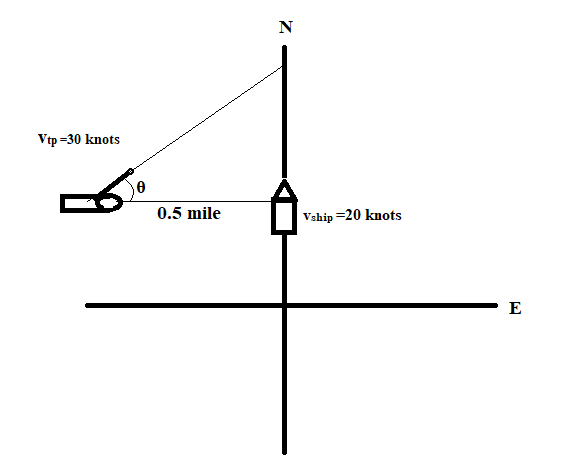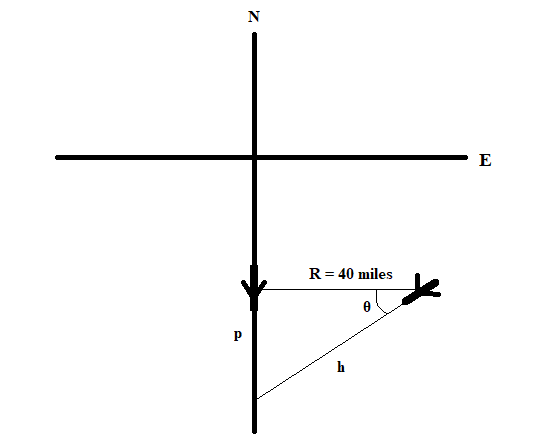
Concept explainers
Use the relative velocity equation and solve graphically or analytically.
a. A ship is steaming due north at 20 knots (nautical miles per hour). A submarine is laying in wait 1/2 mile due west of the ship. The sub tires a torpedo on a course of 85 degrees. The torpedo travels at a constant speed of 30 knots. Will ii strike the ship! If not, by how many nautical miles will it miss?
b. A plane is flying due south at 500 mph at 35.000 ft altitude, straight and level. A second plane is initially 40 miles due east of the first plane, also at 35.000 feet altitude, flying straight and level and traveling at 550 mph. Determine the compass angle at which the second plane would be on a collision course with the first. How long will it take for the second plane to catch the first?
(a)
Whether the torpedo will strike the ship or not and by what distance will it miss the ship.
Answer to Problem 6.1P
The torpedo will miss the ship by 1.91 miles.
Explanation of Solution
Given:
Speed of ship
Speed of torpedo
Course of firing
Separation between ship and submarine(R) = 0.5 mile
Concept Used:
Calculation:
Drawing diagram,

From the above figure,
Now put
It is also calculated that,
Let, time to cover 5.74 miles by torpedo is,
In this duration, the distance travelled by ship is given by,
As the torpedo missed the target. Let it miss the target by a distance s, then,
Therefore, torpedo misses the target by 1.92 miles.
(b)
The compass angle at which the second plane would be on a collision course with the first and the time taken by the second plane to catch the first plane.
Answer to Problem 6.1P
The compass angle at which the second plane would be on a collision course with the first is
Explanation of Solution
Given:
Speed of first plane,
Speed of second plane,
Distance of separation between the planes,
Concept Used:
Calculation:
Drawing diagram,

From the diagram,
To collide head on, the two plane must cover the distances P and h in same time interval. Let it takes time t to cover these distances, then
Further simplify,
Therefore, the compass angle at which the second plane would be on a collision course with the first is
Now, time taken, t is given as,
Therefore, the time taken by the second plane to catch the first plane is 0.176 h.
Want to see more full solutions like this?
- JUST DRAW THE SCHEMATIC DIAGRAM. NO NEED TO SOLVE. THANK YOU In Rizal province, one of its power plants has been thoroughly monitored for possible conversion into a wind power plant. A propeller wind turbine is to be used. Survey showed that Rizal Province at a height of 10 meters above the ground has a minimum wind speed of 7.1 miles per hour duringthe month of June and a maximum wind speed of 12.9 miles per hour during the month of January. The minimum temperature is at 75 degree Fahrenheit during the month of January and maximum temperature is at 89 degree Fahrenheit during the month of May. The existing power plant has an output of 54MW. For the proposed wind power, the power coefficient of turbine is 35% and the generator efficiency is 95%. Theimpeller diameter is assumed not to exceed 90m. Determine the following:a. Theoretical Wind Power Outputb. Electrical Power Outputc. Number of turbines to be installedarrow_forward3. Describe the motion of the ball moving across the following ramp configurations. Please note that the ball can only move to the right and the initial launch speed setting is considered to be to the right as shown by the arrows. A Launch Speed Describe Motion: B Launch Speed > 0 Describe Motion: C Launch Speed > 0 Describe Motion:arrow_forwardAnswer using GRAPHICAL METHOD. Make a representation of the following vector quantities a. A velocity of 20m/s north b. A force of 2000 dynes 45° east of south c. An acceleration of 5m/s2 at 200° d. A displacement of 14m 100° from +x-axis e. A force of 250N at 60° clockwise +x-axisarrow_forward
- 7. In the pulley system shown below, the cylinder moves upward at a velocity of 6.7 ft/s as the cable is pulled by the winch motor. Answer the following questions. a. Use the figure below to label the horizontal and vertical datums. Include all relevant distances needed to evaluate the pulley system. C b. How many individual cables are used in this pulley system? Explain how the number of cables is related to how many equations are needed to describe the motion of the system. Magnitude rounded to 3 sig. fig. B C. What is the velocity of Point A? Show your work. Units Direction (right or left)arrow_forwardUsing graphical method solve this problem: Suppose you first walk A in a direction of B west of north then C in a direction D south of west. You rest for 20 minutes and started to compute the distance you traveled. Take A, B, C and D found in the table below. (You may use scale such as 1cm = 2m in your drawing) C. What is the angle between AC ? D. What is the angle between your first walk A to the resultant R?arrow_forwardE. A particle traveling in a circular path of radius 300 m has an instantaneous velocity of 30 m/s and its velocity is increasing at a constant rate of 4 m/s². What is the magnitude of its total acceleration at this instant?arrow_forward
- DYNAMICS OF RIGID BODIES (UPVOTE WILL BE GIVEN. PLEASE WRITE THE COMPLETE SOLUTIONS. NO LONG EXPLANATION NEEDED. ANSWER IN 2 DECIMAL PLACES. BOX THE FINAL ANSWERS.) PROBLEM #1 (A AND B ARE AT THE SAME LEVEL) A BALL IS SHOT AT A GROUND LEVEL AT AN ANGLE OF 60 DEGREES WITH THE HORIZONTAL WITH AN INITAL VELOCITY OF 100m/sec. Determine the following: d) FIND THE VELOCITY OF THE BALL AFTER 2 secs e) FIND THE HORIZONTAL DISTANCE (R) COVERED BY THE BALL FROM A TO B f) FIND THE TIME OF FLIGHT (t) OF THE BALL FROM A TO B.arrow_forward(232,100,350) (432,700,50) The AWM sniper rifle fires a bullet at an initial speed of 3,071 ft/s. As shown in the figure above, a soldier is aiming an AWM rifle at a target. According to the Cartesian coordinate system defined at the top left corner of the figure, the muzzle of this rifle locates at (232,100,350) meter and the target locates at (432,700,50) meter. At this time point, the soldier fires a bullet; please write down the velocity vector (v) of this bullet, based on the given coordinate system. (Round numbers to integers.) î+ ĵ+ where î, ĵ, and k are the unit vectors associated with the positive x, y, and z axes of the given coordinate system, respectively. Assumptions: the bullet travels along a straight line at a constant speed.arrow_forwardThere are three base stations (M1, M2 and M3) that can send and receive signals from your mobile phone (at location Z). Suppose that in a cartesian coordinate system these base stations are located at (0,0), (36, 0) and (16,32), respectively, find the coordinates of Z. The distances between you (at point Z) and the base stations are 29 km, 25 km and 13 km, respectively. (Note: 1 map unit is equivalent to 1 km distance)arrow_forward
- (10 points) Crank_Slider2 a WOP, dop Known values: a 0.38 m 3.4 m 20° 68° Problem Statement: Crank OP rotates about fixed axis O, causing slider Q to oscillate in a horizontal track. At the instant depicted, the angular velocity of crank OP is 4 rad/s and its angular acceleration is 6 rad/s?. For that instant, determine the following. The velocity vector of pin P: i+ 1.4283 m/s -0.5199 m/s The angular velocity of rod PQ: The velocity vector of slider Q: The acceleration vector of pin P: 计 The angular acceleration of rod PQ: The acceleration vector of slider Q: i+arrow_forwardThe single axis robot arm given below moves parallel to the paper plane around the O point. a. Find the position, velocity and acceleration equations of the linear trajectory with parabolic parts that will bring this robot arm from -30 starting position to +30 end position in 3 seconds with zero start and end velocities. Take the acceleration times as 1 second. b. Using these equations, find the position velocity and acceleration of the robot arm at t = 2.5 seconds.arrow_forwardDYNAMICS OF RIGID BODIES (UPVOTE WILL BE GIVEN. PLEASE WRITE THE COMPLETE SOLUTIONS AND FBD LEGIBLY. NO LONG EXPLANATION NEEDED. ANSWER IN 2 DECIMAL PLACES. BOX THE FINAL ANSWER.) A ball is shot Vertically into the air at a of 193.20 ft/sec. After 4 secs another ball is shot Vertically into the air. What initial velocity must the second ball have in order to meet the first ball 386.40 ft. from the ground?arrow_forward
 Elements Of ElectromagneticsMechanical EngineeringISBN:9780190698614Author:Sadiku, Matthew N. O.Publisher:Oxford University Press
Elements Of ElectromagneticsMechanical EngineeringISBN:9780190698614Author:Sadiku, Matthew N. O.Publisher:Oxford University Press Mechanics of Materials (10th Edition)Mechanical EngineeringISBN:9780134319650Author:Russell C. HibbelerPublisher:PEARSON
Mechanics of Materials (10th Edition)Mechanical EngineeringISBN:9780134319650Author:Russell C. HibbelerPublisher:PEARSON Thermodynamics: An Engineering ApproachMechanical EngineeringISBN:9781259822674Author:Yunus A. Cengel Dr., Michael A. BolesPublisher:McGraw-Hill Education
Thermodynamics: An Engineering ApproachMechanical EngineeringISBN:9781259822674Author:Yunus A. Cengel Dr., Michael A. BolesPublisher:McGraw-Hill Education Control Systems EngineeringMechanical EngineeringISBN:9781118170519Author:Norman S. NisePublisher:WILEY
Control Systems EngineeringMechanical EngineeringISBN:9781118170519Author:Norman S. NisePublisher:WILEY Mechanics of Materials (MindTap Course List)Mechanical EngineeringISBN:9781337093347Author:Barry J. Goodno, James M. GerePublisher:Cengage Learning
Mechanics of Materials (MindTap Course List)Mechanical EngineeringISBN:9781337093347Author:Barry J. Goodno, James M. GerePublisher:Cengage Learning Engineering Mechanics: StaticsMechanical EngineeringISBN:9781118807330Author:James L. Meriam, L. G. Kraige, J. N. BoltonPublisher:WILEY
Engineering Mechanics: StaticsMechanical EngineeringISBN:9781118807330Author:James L. Meriam, L. G. Kraige, J. N. BoltonPublisher:WILEY





